Standard [CURRENT]
ASTM D 7522/D 7522M:2021
Standard Test Method for Pull-Off Strength for FRP Laminate Systems Bonded to Concrete or Masonry Substrates
- Publication date
- 2021
- Original language
- English
- Pages
- 6
- Publication date
- 2021
- Original language
- English
- Pages
- 6
- DOI
- https://dx.doi.org/10.1520/D7522_D7522M-21
Product information on this site:
Quick delivery via download or delivery service
Buy securely with a credit card or pay upon receipt of invoice
All transactions are encrypted
Short description
1.1 This test method describes the apparatus and procedure for evaluating the pull-off strength of wet lay-up or pultruded (shop-fabricated) Fiber Reinforced Polymer (FRP) laminate systems adhesively bonded to a flat concrete substrate. The test determines the greatest perpendicular force (in tension) that an FRP system can bear before a plug of material is detached. Failure will occur along the weakest plane within the system comprised of the test fixture, FRP laminate, adhesive, and substrate. 1.2 This test method is primarily used for quality control and assessment of field repairs of structures using adhesive-applied composite materials. 1.3 This test method is appropriate for use with FRP systems having any fiber orientation or combination of ply orientations comprising the FRP laminate. 1.4 This test method is appropriate for use with flat concrete, concrete masonry, clay masonry, and stone masonry substrates. 1.5 This test method is not appropriate for use as an "acceptance" or "proof" wherein the FRP system remaining intact at a prescribed force is an acceptable result. 1.6 Pull-off strength measurements depend upon both material and instrumental parameters. Different adhesion test devices and procedures will give different results and cannot be directly compared. 1.7 This test method can be destructive. Spot repairs may be necessary. The test method will result in an exposed cut FRP section; repair methods must consider the potential for moisture uptake through this cut section. 1.8 Prior to the installation of some adhesively bonded FRP systems, the substrate must be patched. This test method is not appropriate for determining the pull-off strength of the FRP from the patch material. An additional test method is required to determine the pull-off strength of the patch from the substrate. 1.9 Units- The values stated in either SI units or inch-pound units are to be regarded separately as standard. The values stated in each system are not necessarily exact equivalents; therefore, to ensure conformance with the standard, each system shall be used independently of the other, and values from the two systems shall not be combined. 1.10 This standard does not purport to address all of the safety concerns, if any, associated with its use. It is the responsibility of the user of this standard to establish appropriate safety, health, and environmental practices and determine the applicability of regulatory limitations prior to use. 1.11 This international standard was developed in accordance with internationally recognized principles on standardization established in the Decision on Principles for the Development of International Standards, Guides and Recommendations issued by the World Trade Organization Technical Barriers to Trade (TBT) Committee.
ICS
91.100.40
DOI
https://dx.doi.org/10.1520/D7522_D7522M-21
Also available in
Loading recommended items...
Loading recommended items...
Loading recommended items...
Loading recommended items...

